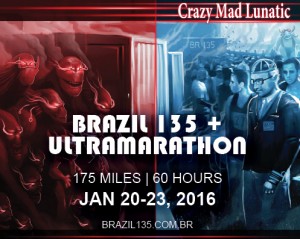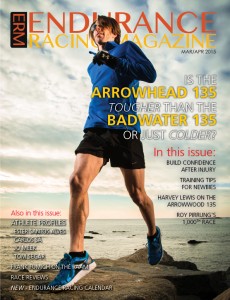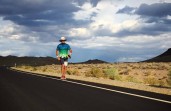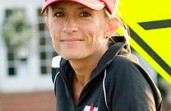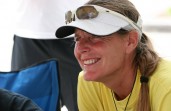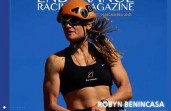By Alix Jean Shutello
“She stood alone – faster not only because it was a natural born talent – but she honed her skills; becoming fitter, faster and better than the rest. It was no accident she started winning. It was like the Gods willed her to succeed, and succeed she did.”
[Foreward]
 er began competing in a variety of triathlon distances. In February 1982, during the Hawaiian Ironman, the world watched Julie Moss as her body began to fail her. And just before Moss slumped to her knees and began to crawl, Kathleen McCartney passed her just yards from the finish line and won the IronmanWorld Championship. Dahlkoetter watched the race with keen interest.
er began competing in a variety of triathlon distances. In February 1982, during the Hawaiian Ironman, the world watched Julie Moss as her body began to fail her. And just before Moss slumped to her knees and began to crawl, Kathleen McCartney passed her just yards from the finish line and won the IronmanWorld Championship. Dahlkoetter watched the race with keen interest.Oddly, the Hawaiian Ironman held a second championship race that same year, and by that time, Dahlkoetter was swimming 4-5 miles, cycling 150 miles, and running 30 miles per week. She set her eyes on the Ironman and in October 1982, Dahlkoetter embarked on a race that would change her life once again. Before the race, she convinced an ABC News correspondent to interview her, and with the cameras rolling, Dalhkoetter said that she would use her experience in sports psychology to place in the top five women.
And ultimately, using mental imagery and perseverence, Dahlkoetter moved up from 19th place, passing an exhausted McCartney to come in 2nd place in one of the greatest comebacks in Ironman history.
During a time in U.S. history when equality in women’s sports was beginning to take root, competing in the marathon and other endurance races became both popular and contentious for women. Athletes like Dahlkoetter were not willing to merely sit back and watch an era of endurance sports pass them by – they chose to become part of American history.
Dahlkoetter’s life is one life-long quest for the next adventure through the wild world of all sports. It was the physicality of these sports that developed her body so when it was time to compete, it was just a matter of execution and mental fortitude that made her a top U.S. athlete.
This is Dr. JoAnn Dahlkoetter’s story.
JoAnn Dalhkoetter was born to Art and Beth Dalkoetter in Omaha Nebraska in 1955. When Dahlkoetter was 5, the family moved to Santa Barbara, CA, where her father took a job working at his brother’s bowling alley. Soon the family business flourished, and Dahlkoetter spent hours after school in her Uncle Ernie’s bowling alley where she spent time with her father. When she wasn’t in the bowling alley, Dahlkoetter was cycling around the neighborhood for hours at a time on the bicycle she begged her parents for at Christmas time.
Exercise was a way of life for Dahlkoetter in her early years. After attending Santa Barbara’s Franklin Elementary school, she and her brother, Mike, transferred to Cleveland Middle School where they walked 2 miles to and from school. The school, a prestigious elementary school located uphill from her home where her mother, Beth, worked in the cafeteria, allowed Dahlkoetter to mingle with wealthier kids. While there were no formal physical education classes at either of her elementary schools, Dahlkoetter was very physically active and often would race the kids whenever there was opportunity.
“I majored in recess back then,” she said.
While there was no formal running program at Cleveland Middle School, Dahlkoetter quickly established herself as one of the top sprinters. The only kid who alluded her was Alton Hayes, the school’s fastest sprinter, who she often challenged to 100m to 400m sprints on the school playground. Finally, in 6th grade, Dahlkoetter beat Hayes, using her long stride to pass him at the finish line.
In 1967, Uncle Ernie sold his Bowling Alley and Art moved the family 10 miles north of Santa Barbara to Goleta, where he took another job at local bowling alley. Dahlkoetter and her brother attended the Goleta Junior High School.
Again, the school had no formal physical education program, but the school participated in an event called the Sports-O-Rama. Dahlkoetter signed up for and competed in a number of events ranging from the 400m to high jumping and swiftly won all the events. To this day, her trophies from the event adorn her bookshelves.
“Back then I was competing freely without any pressure, so it was a lot of fun to participate in any event I could think of. I had no fear, and just ran,” she said.
A Surfer Girl Becomes a Multi-Sport Athlete
Dahlkoetter left Goleda Junior High for Dos Pueblos Highschool, and in 9th grade, her friend, Sharon Roland, introduced her to surfing. Born out of desire to have a buddy in a sport where only a few women participated, Sharon asked Dahlkoetter to join her. It wasn’t long before Dahlkoetter had her own board and Beth would drop the girls off at the local beach and the two would surf with the guys for hours. The energy of the waves and movement of water from the ocean became the first images that would Dahlkoetter would use to succeed in her racing career.
Surfing took up the majority of Dahlkoetter’s time in high school. Without any formal physcial education programs for girls at school, she was fine with surfing and cycling.
Dahlkoetter attended the University of Pacifica in Stockton, California and majored in psychology and music therapy. It was there that Dahlkoetter started to experiment with extreme sports such as rock climbing, parachuting, and flatwater kayaking. Ever the water enthusiast, she continued surfing but took to kayaking and soon, Dahlkoetter was teaming up with athletes who were training for the Olympics where she’d spend hours rowing the Berkley Estruary. Dahlkoetter and her friends kayaked down expert class 5 rapids and mini waterfalls.
“It was very scary stuff, but I had no fear at that time. The more extreme, the better,” she said.
A friend took her under her wing and showed her how to craft and build her own fiberglass kayak. “Fiberglass is nasty stuff to work with,” Dahlkoetter commented. “There’s lots of itching and coughing and it sticks to your skin and clothes. But it was worth it to build my own custom kayak that I used for many years.”
While at Stockton, Dahlkoetter started running to keep in shape, but she mainly hung around with friends in the cycling club. The group would do long rides out of the flat terrain of Stockton into the Sierra Nevadas which were about 40 miles to the west. It wasn’t long before she was in good enough shape to try a few races. She found herself competing in cycling races including the Davis Double Century in Davis, CA in May of 1974, which was her first endurance race. In her senior year, she signed up for the 5000-mile Bike Centennial trek across the USA in the summer of 1976.
To prepare, she cycled 100 miles on the weekends for six months prior to race. She then cycled 100 miles a day for two months across the country from Oregon to Virginia spending night after night roughing it in tents. What made the race even tougher was that riders had no sag wagon or support crew. Cyclists carried their own campaign equipment and bought food at grocery stores along the way. “Our budget was $3.33 per day; just barely enough for food and campground fees,” Dahlkoetter said.
During the course of the centenial ride, Dahlkoetter and the other cyclists would cross the Continental Divide 9 times, climbing every mountain they came across. The ride, would prove to be a true learning experience, as cyclists had to live through the grit and exhaustion of each day.
“Mental toughness was a requirement for this journey, and this trip really toughened me up for sure, forming the foundation for my passion for endurance sports, which I carry with me to this day,” she said.
A Runner is Born
In the fall of 1976, Dahlkoetter left Stockton to pursue a graduate degree in psychology at West Virginia University in Morgantown, VA. Stuffing her car full of sporting gear, including her hand-made kayak, she drove across the country to pursue her doctorate in sports psychology. Upon arriving on campus, however, she quickly discovered West Virginia’s caves and added spelunking to her resume of extreme sports.
JoAnn after winning the Catalina 10K
 Running, however, had not missed Dahlkoetter’s eye. While she was growing up and going through high school and college, Americans such as Jack Bacheler, Frank Shorter, and Jeff Galloway qualified for the Olympics in Munich, Germany in 1972. Shorter went on to win the Olympic Marathon, but by 1975, Bill Rodgers surfaced as the new super star winning and setting a new record in the Boston Marathon. As his career took off in the late 1970s and early 1980s, a shift happened in the United States. Title IX surfaced to provide equality for women who were already making strides themselves in long distance running; many of whom were sneaking into endurance races like the infamous Roberta “Bobbi” Gibb, who snuck in and ran the Boston Marathon in 1966 in just over 3 hours (see Suggested Reading).
Running, however, had not missed Dahlkoetter’s eye. While she was growing up and going through high school and college, Americans such as Jack Bacheler, Frank Shorter, and Jeff Galloway qualified for the Olympics in Munich, Germany in 1972. Shorter went on to win the Olympic Marathon, but by 1975, Bill Rodgers surfaced as the new super star winning and setting a new record in the Boston Marathon. As his career took off in the late 1970s and early 1980s, a shift happened in the United States. Title IX surfaced to provide equality for women who were already making strides themselves in long distance running; many of whom were sneaking into endurance races like the infamous Roberta “Bobbi” Gibb, who snuck in and ran the Boston Marathon in 1966 in just over 3 hours (see Suggested Reading).Dahlkoetter, who kept tabs on women competing in the marathon, was most impressed by Gayle Barron, recognized as the “First Lady” in running by Runner’s World Magazine. Gayle Barron was on the cover of the 1976 issue of the magazine. One of the recognized pioneers of American road racing, Barron was the winner of the 6 Peach Tree 10Ks, earning her the endearing title of “The First Lady of Peachtree.” Barron was also a well-known marathoner. Dahlkoetter was motivated by the fact that a woman made the cover of a prestigous sports magazine. Little did she know, that she was a few short years away from being recognized as one of the top runners in the country.

Gayle Barron (in Red) was an inspiration to Dahlkoetter, Photo Courtesy of Runners World Magazine
The Running Phenom
In the summer of 1977, still at WVU, Dahlkoetter interned down in Charleston, SC. It was there that a group of friends ask her to join them in a run. By the end of the summer, Dahlkoetter ran in and won the Charleston 10-mile Distance Run.
Dahlkoetter returned to Morgantown she competed in her first 15k in West Virginia. She won the race and received a chunk of coal for her award. Dahlkoetter joined Carl Hatfield’s track team, the West Virginia Track Club (WVTC), which was a national ly recognized running club during the 1970s. Led by Hatfield who founded the club, WVTC won the team championship at the 1974 Boston Marathon and the national marathon championship at the 1978 Skylon International Marathon, which Hatfield just happened to win in course-record time. Dahlkoetter worked with Carl in the fall and in two short months, Dalhkoetter raced in the New York City Marathon.“Back then the race was not as popular as it is today but the idea of travelling to New York City to compete sounded like an adventure to me,” Dahlkoetter said.
Dahlkoetter finished the NYC Marathon in a swift 3:04 and came in top 11th female, securing her as a top US marathoner at the age of 25. The race, however, took its toll and Dahlkoetter not only became injured as a result of the race, but her injuries would plague her on and off for years to come. Despite this, Dahlkoetter continued to run when she could. In her sophomore year at WVU, Dahlkoetter interned abroad in the old coal mining town of Barnsley, a town in South Yorkshire, England as part of an program for psych research. The rolling hills of the Berkshires proved to be a good training ground and in early 1979, Dahlkoetter ran the Barnsley Marathon in a swift 3:01.

JoAnn with Frank Shorter at NYC Marathon
In November of 1979, Grete Waitz won the New York City Marathon. This was an inspiration to Dahlkoetter, who moved to Oregon after her internship was over and spent the spring and summer of 1980 in Oregon on another internship at the Portland Medical Center. In her spare time, Dahlkoetter was trained with Jim Hapmton doing speedwork with top U.S. runners on the track.
Dahlkoetter remembered the fateful day on May 18, 1980 when Mt. Saint Helen in Washington state errupted. She was on the track at the time, and she and other runners couldn’t believe their eyes. The erruption pulverized land for miles around and an eruption column rose 80,000 feet (24,400 m) into the atmosphere and depositing ash in 11 U.S. states. For days and weeks afterwards, Dahlkoetter and her fellow runners ran with masks on to filter out the ash which permeated the air and everything else.
Winning San Francisco
Dahlkoetter competed in local races including the Cascades 15K, a local race that attracted some of the best distance runners in the country. Dahlkoetter ran at 5:45 pace and finished in the top 10 of the elite women’s division, bolstering not only Dahlkoetter’s reputation as a distance runner, but her confidence as well. Three weeks later, she lined up for the San Francisco Marathon, ran a 6:10 pace, and won the 1980 San Francisco Marathon in 2:43 and broke the course record by 6 minutes. For Dahlkoetter, she beat her personal best by 20 minutes.
“Back then there was no Gu or other products to give you nutrition during the race,” Dahlkoetter commented. “I ran that race having drank water only.”

That astonishing effort put Dahlkoetter on an all-time high, but instead of resting after the Marathon, she continued to train and race with a body that was already rife with injuries. The lack of adequate recovery put undo stress on Dahlkoetter’s joints and after competing a local 5K a few weeks later, her life took another fateful turn, and she pulled up with a stress fracture in her tibia. The stress fracture set her back six months, so in April 1981, Dahlkoetter took up cycling and swimming as the only exercises she could endure to keep her in peak condition.
Dahlkoetter Transforms into a Triathlete
Dahlkoetter moved to San Francisco to start her sports psychology practice and continued to train throughout 1981, and during so, she kept her eye on the pulse of competitive sports. Given her physical conditioning in cycling and swimming, Dahlkoetter slowly incorporated running back into her training and soon she joined the local triathlon club where she began to complete in local triathlons. It wasn’t long before her second tremendous athlete feat would present itself to her.
In February 1982, Dahlkoetter watched the tragic finish of the Hawaiian Ironman when Julia Moss, the lead competitor, began to stumble. She exhausted herself to the point where she was incapable of standing, and became known as the first woman to crawl to the finish line. Veteran superstar Kathleen McCartney passed Moss just yards from the finish line and won the women’s division of the Hawaiian Ironman in one of the most dramatic finishes in history. In fact, McCartney didn’t even know she had won until a volunteer told her.
Moss, the lead competitor, began to stumble. She exhausted herself to the point where she was incapable of standing, and became known as the first woman to crawl to the finish line. Veteran superstar Kathleen McCartney passed Moss just yards from the finish line and won the women’s division of the Hawaiian Ironman in one of the most dramatic finishes in history. In fact, McCartney didn’t even know she had won until a volunteer told her.
Oddly, as if by fate, the Hawaiian Ironman decided to add a second race that year, and in October of 1982, Dahlkoetter toed the line in one of the world’s most well know Ironman distance races.
Given her past performance in other races, Dahlkoetter was a top seeded competitor, and a helicopter followed her as ABC Wild World of Sports followed the top athletes like McCartney, who was back to attempt a repeat win.
“You know you’ve made it when you have a helicopter following you,” Dahlkoetter chuckled. “Before that race, however, I was still a relative unknown to the triathlete world. I forced my way into the correspondents’ tent and asked ABC News Correspondent and endurance swimmer, Diana Nyad, to interview me. Fortunately, I was able to remain humble and talked about how I was going to compete in the race. I talked about my background in psychology and visualization and how I would use it and that I expected to come in as one of the top competitors in the race.”
Dahlkoetter went out conservatively, but toward the end of the race, she began to close in and moved herself up from 19th to 3rd place, right behind McCartney. Not knowing where McCartney was, Dahlkoetter could only push herself forward mile after mile, and as she eeked herself closer and closer to McCartney, who was now walking from fatigue, all Dahlkoetter could see was her helicopter.
“You never knew where people were in the race,” Dahlkoetter said. “It wasn’t until I looked up and saw Kathy’s helicopter that I knew I was closing in, and I ran, just ran toward that helicopter,” Dahlkoetter said.
Dahlkoetter soon would add a dramatic finish to her accomplishments as ABC News aired Dahlkoetter swiftly passing McCartney into 2nd without slowing, even as she raced toward the finish. Her 2nd place finish boosted not only Dahlkoetter’s athletic career but her sports psychology practice as well. Soon, people wanted to know how this top athlete used her mind to win races. Triathlete Magazine named here the number 1 triathlete in the U.S.
 Click here to see the ABC News footage of the HI Ironman.
Click here to see the ABC News footage of the HI Ironman.
Unfortunately, the Ironman Championships would be the last race Art Dahlkoetter would see. While he was too infirm to actually be at the race, he had the opportunity to see his daughter race on ABC several months after the race when it aired. Art had been an influence in Dahlkoetter’s life, and would bike beside her sometimes while she ran. He passed away peacefully at the age of 82 soon after the Ironman aired.
Dahlkoetter would go on to compete in two more triathlons in a 6-week period as invitations came from the U.S. and abroad. She competed in Malibu and France before settling back into her medical practice in San Francisco, where she built her career from 1982 to the present training top athletes for everything from the Olympics to other sports ranging from triathletes to tennis and golf players to equestrians.
Present Day Achievements
Today, Dahlkoetter continues to race and finishe at the top of her age group. In the past 30 years, Dahlkoetter has trained Olympians in the past four Olympics.
As a result of Dahlkoetter’s internationally recognized work, (as seen on OPRAH, ABC, BBC, NBC-TV Olympics), many coaches and professionals are personally trained under Dr. Dahlkoetter to learn her specialized “Performing Edge Coaching” process. Over the last several years, Dahlkoetter developed her Performing Edge Coach Certification program (http://PerformingEdgeCoach.com ), and she now trains coaches, psychologists, and health professionals worldwide online to expand her work with her customized sports psychology mental training process for peak performance with athletes at any level in a variety of sports.
Dr. Dahlkoetter is celebrating the 10th anniversary of her book “Your Performing Edge”, now in 25 countries (in its fourth edition, updated) and is offering a special Performing Edge video training series, FREE when you purchase the book (visit http://www.drjoann.com/products/book/ for more details).
Biography
 Dr. JoAnn Dahlkoetter, is CEO of Performing Edge Coaching International Association,(http://www.PerformingEdgeCoach.com) a global resource and Certification Training Program for coaches, and founder of http://www.DrJoAnn.com the premiere sports psychology resource for athletes, coaches and sports parents. Dr. JoAnn is best-selling author of YOUR PERFORMING EDGE™, (http://www.sports-psych.com ) on OPRAH and NBC-TV, Stanford Performance Consultant, sports psychologist to OLYMPIC Gold Medalists and CEOs, winner of the San Francisco Marathon and 2nd in the World Championship Hawaii Ironman Triathlon. She is Host of the internationally syndicated TV Show – “Your Performing Edge”, an internationally recognized Olympic Keynote Speaker, columnist, and TV expert commentator.
Dr. JoAnn Dahlkoetter, is CEO of Performing Edge Coaching International Association,(http://www.PerformingEdgeCoach.com) a global resource and Certification Training Program for coaches, and founder of http://www.DrJoAnn.com the premiere sports psychology resource for athletes, coaches and sports parents. Dr. JoAnn is best-selling author of YOUR PERFORMING EDGE™, (http://www.sports-psych.com ) on OPRAH and NBC-TV, Stanford Performance Consultant, sports psychologist to OLYMPIC Gold Medalists and CEOs, winner of the San Francisco Marathon and 2nd in the World Championship Hawaii Ironman Triathlon. She is Host of the internationally syndicated TV Show – “Your Performing Edge”, an internationally recognized Olympic Keynote Speaker, columnist, and TV expert commentator.
Dr. JoAnn provides sports psychology, mental training and Performing Edge Coach Certification programs for coaches, parents and young athletes to reach their highest potential in sports and life. Call 650-654-5500 to have your custom peak performance MP3 audio created for your exact needs . FREE Private Mentoring program at http://www.PeakPerformancePlan.com.
Dr. Dahlkoetter is a licensed psychologist and has been a medical staff member at the University of California at Berkeley for 10 years, and frequently conducts workshops for corporations, universities, and sports clinics worldwide. She currently maintains a full-time private practice and continues to train and race in the San Francisco Bay Area. Her work with champion athletes and top-level business executives gives her special insight into using the mind-body connection to achieve the best in personal performance.
She is winner of the SAN FRANCISCO MARATHON in 2:43:20, placed 2nd in the HAWAII IRONMAN TRIATHLON, and was rated the No. 1 triathlete in the U.S. by TRIATHLETE MAGAZINE.
Dr. JoAnn Dahlkoetter Sports Psychology Expert and Performance Coach
- Best-selling uthor, YOUR PERFORMING EDGE
- On OPRAH and NBC OLYMPICS – TV Commentator
- Coach to CEO’s and Olympic Gold Medalists
- Winner, San Francisco Marathon
- World Championship Hawaii Ironman
- Triathlon, Champion athlete
- Stanford University Medical Center – on Medical Staff for 10 years
- OLYMPIC Keynote Speaker for corporations worldwide
Phone (650) 654-5500 Email: [email protected]
Performing Edge Coaching International 3341 Brittan Ave., Suite #10 San Carlos, CA 94070
Suggested Reading:


